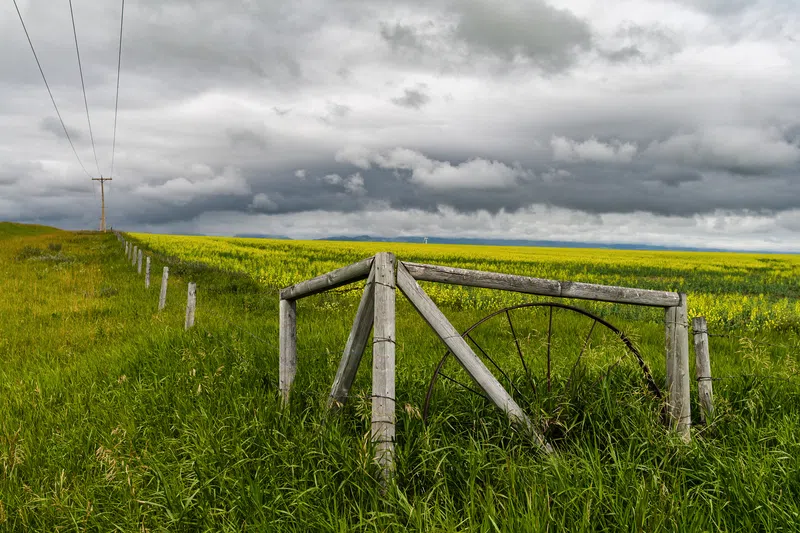Crop conditions in Region Four (North West) rated good to excellent sit at 49 per cent, below the five- and 10-year averages of 60 per cent.
That’s according to the June 17 crop report from the Agriculture Financial Services Corporation (AFSC) and the Government of Alberta.
On the other hand, tame hay conditions have reportedly improved from last week. Current ratings show pasture (tame hay) at 10 (15) per cent poor, 29 (27) per cent fair, 59 (36) per cent good, and two (21) per cent excellent.
Surface (sub-surface) soil moisture conditions are rated 14 (35) per cent poor, 35 (15) per cent fair, 42 (45) per cent good, nine (five) per cent excellent, and one (zero) per cent excessive.
Meantime, pest pressure has been minimal though grasshoppers, gophers, and army cutworms are reported to be above threshold, but not at high levels.
Overall, recent rainfall has brought some relief to the Central and North East Regions, but dryland crops and pastures in the South Region remain under stress due to ongoing dry conditions, the report notes.
Provincial crop conditions are rated 50 per cent good to excellent, below the five- and 10-year averages of 71 and 70 per cent, respectively. However, with continued precipitation this week, conditions are expected to improve in the coming weeks.
Major crops are currently all rated below their historical averages, with good to excellent conditions ranging from 45 per cent for canola to 52 per cent for dry peas. While conditions have varied, the AFSC and provincial government say crop development remains ahead of typical seasonal progress, with spring cereals nearing stem elongation and fall-seeded crops well into flowering.
In the South Region, canola and dry peas are progressing quickly. About 40 per cent of canola is in the rosette stage, with five per cent already flowering, while 44 per cent of dry peas have reached the seven to 12 node stage.
Post-emergent spraying is taking place in all regions, with the South and Central leading at 84 and 77 per cent complete, respectively, and the Peace Region lagging at 34 per cent.
Provincially, 66 per cent of spraying is complete, ahead of the five- and 10-year averages of 49 and 51 per cent, respectively. Pest pressures are low, with grasshoppers rated as minimal activity provincially at 86 per cent, consistent with historical averages. Flea beetles are more active in the South Region, with seven per cent of fields rated over thresholds, while other pests are rated as minimal and no major outbreaks have been reported.
When it comes to tame hay growth, the report says recent precipitation has contributed to improving moisture conditions, but early season dryness continues to slow pasture and tame hay growth across the province.
Compared to last week, pasture conditions have improved slightly provincially, with the proportion rated good to excellent rising to 41 per cent (up four per cent), while tame hay ratings declined to 38 per cent (down two per cent). Provincially, pasture (tame hay) growth conditions are rated at 17 (19) per cent poor, 42 (44) per cent fair, 39 (31) per cent good, and two (six) per cent excellent.
Overall, 59 per cent of pastures and 62 per cent of tame hay fields remain in poor to fair condition, with good to excellent ratings below the five- and 10-year averages across all regions. The North West Region is the exception, with pastures one per cent higher than the 10-year average, though they still reportedly show signs of stress.
The North West leads in pasture growth, with 61 per cent rated good to excellent, followed by Central (46 per cent), South (39 per cent), North East (32 per cent), and Peace (27 per cent).
The North West also leads in tame hay conditions (five-year averages), with 57 (73) per cent rated good to excellent, compared to 32 (55) per cent good to excellent in the South Region, 43 (71) per cent good to excellent in the Central Region, 26 (57) per cent good to excellent in the North East Region and 25 (60) per cent good to excellent in the Peace Region.
Inadequate pasture and hay growth in some parts of South and Central Regions has led to early cutting of hay, while recent rains are aiding recovery in the Peace Region.
In terms of moisture, most areas across the province received two to 10 mm of precipitation this week. The Peace Region saw the highest rainfall, with widespread rain of 30–50 mm and some locations exceeding 45 mm. The North West and North East Regions received two to 15 mm, with some isolated areas up to 30 mm. Some parts of the Central Region recorded two to 10 mm, while the South remained the driest, with most areas under 10 mm.
Rainfall over the week led to noticeable improvements in soil moisture reserves across all regions. The report notes, however, surface and sub-surface moisture levels rated good to excellent remain below the five- and 10-year averages in all areas. Provincially, surface moisture stands at 37 per cent good to excellent, up 17 per cent from last week, while sub-surface moisture is at 38 per cent good to excellent, up 11 per cent over the same period.
Regionally, surface soil moisture rated good to excellent has improved (changes from last week) and is reported at 50 (plus 16) per cent in the North West, 25 (plus six) per cent in the South, 41 (plus 25) per cent in the Central, 40 (plus 23) per cent in the North East, and 46 (plus 21) per cent in the Peace Region.
Sub-surface soil moisture ratings are 50 (+18) per cent in the North West, 26 (plus seven) per cent in the South, 42 (plus seven) per cent in the Central, 35 (+18) per cent in the North East, and 54 (+17) per cent in the Peace Region. While improvements have been seen across the province, dryness is still evident in parts of the South, Central, and North East Regions.













Comments